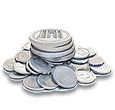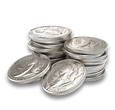Rarity vs Condition: Which Matters More for Long-Term Coin Value?
- GoldsilverJapan

- Sep 26
- 5 min read
In the world of coin collecting and precious metal investing, few debates stir as much discussion as the age-old question: What matters more for long-term coin value—rarity or condition? Whether you're a seasoned numismatist or a beginner looking to start your portfolio, understanding the dynamic between these two factors is essential for making informed, profitable decisions.
This comprehensive guide will help you navigate this nuanced topic. We'll cover definitions, historical examples, real-world data, and expert strategies for collectors and investors alike. By the end, you'll know how to assess coin value based on rarity, grade (condition), and market demand, so your investments have a better shot at long-term appreciation.
🧩 Understanding the Basics
What is Rarity?
Rarity refers to how uncommon a coin is in the market. A rare coin may have been minted in small numbers, have low survival rates, or be difficult to find in any condition.
Types of Rarity:
Mintage Rarity: Few were ever made.
Survivor Rarity: Many were minted, but few survived.
Conditional Rarity: Many exist, but few in high-grade condition.
Demand Rarity: Not rare in quantity, but rare in desirability.
What is Condition?
Condition, often described in terms of grade, indicates the physical state of a coin—how worn, clean, or preserved it is.
Grading Scales:
Sheldon Scale (1–70): Commonly used by PCGS, NGC, and other certification agencies.
Descriptive Grades: Good (G), Very Fine (VF), Extremely Fine (XF), About Uncirculated (AU), Mint State (MS).
Even slight differences in grade (e.g., MS-64 vs MS-66) can mean thousands of dollars in value difference.
⚖️ Rarity vs Condition: A Comparative Framework
Let’s explore how each factor contributes to a coin’s long-term value.
1. Scarcity Creates Demand, But Only to a Point
Rarity can create urgency and exclusivity—but if a coin is so rare that few people know about it or want it, it may not be liquid.
Example:
The 1794 Flowing Hair Dollar is extremely rare and valuable.
Some obscure foreign coins may be just as rare, but not nearly as valuable due to low demand.
✅ Takeaway: Rarity is important—but only when matched with collector or investor demand.
2. Condition Boosts Eye Appeal and Buyer Confidence
A coin in pristine condition attracts both collectors and investors. High-grade coins fetch premiums at auction and are easier to sell.
Example:
A Morgan Silver Dollar graded MS-65 may sell for 10–50x more than one graded VF-20—even though both are common coins.
✅ Takeaway: High condition multiplies value, especially for popular coins.
3. The Sweet Spot: Rare Coins in Top Condition
Coins that are both rare and high-grade command the highest premiums.
Example:
The 1909-S VDB Lincoln Cent in MS-66 RD (Red) condition is exceedingly rare and can fetch six figures.
✅ Takeaway: If you can find rarity and condition in one coin, you’ve hit numismatic gold.
📈 Historical Case Studies
Case Study 1: 1933 Double Eagle ($20 Gold Coin)
Rarity: Extremely rare due to being melted by the U.S. government.
Condition: One in MS-65 sold for $18.9 million in 2021.
Conclusion: Rarity and condition combined = massive premium.
Case Study 2: 1964 Kennedy Half Dollar (Accented Hair Proof)
Rarity: Considered a scarce variety.
Condition: Proof versions in PF-69 sell for $1,000+.
Lower Grade: PF-60 or below versions fetch much less.
Conclusion: Variety plus high condition equals collector demand.
Case Study 3: Roman Denarius – EID MAR Coin
Rarity: Only ~100 known.
Condition: One in Very Fine (VF) condition sold for over $4 million.
Conclusion: Rarity overwhelmed condition in this case due to historical significance.
💼 Investment Strategy: When to Prioritize Rarity or Condition
If You're a Collector:
Prioritize coins with historical or emotional appeal.
Seek condition within your budget, but don’t ignore uniqueness.
If You're an Investor:
Focus on high-grade certified coins with demand history.
Avoid ultra-rare coins with niche appeal unless you're highly experienced.
🔍 Market Trends & Auction Data
High-Grade Common Coins:
2023: A Morgan Dollar MS-67 sold for $2,500, even though the same date in XF trades for $50.
Trend: Investors trust third-party grading; condition is king in many bullion markets.
Rare But Low-Grade Coins:
Example: A coin with a mintage of only 100 may still sit unsold if it's worn flat and unattractive.
Conclusion: Rarity alone is not enough in most markets.
💬 What the Data Says
Factor | Impact on Value | Long-Term Trend |
Rarity (Low Supply) | High impact | Increasing |
Grade (Condition) | Very high impact | Especially in modern coins |
Historical Significance | Depends | Very high for ancient/unique |
Market Demand | Critical | Changes with time |
🧠 Psychological Factors in Coin Valuation
People buy coins for many reasons:
Emotional connection: National pride, heritage
Aesthetic appeal: Shiny, symmetrical, artistically beautiful coins
Fear of missing out (FOMO): Limited mintages, “last of a series”
Confidence in grading: Certified coins build trust
Grade often makes a coin look better, which is crucial in visual hobbies.
🔄 Liquidity: Easier to Sell High-Grade Coins
Dealers and auction houses prefer coins that are:
Certified
In excellent condition
Popular with collectors
Implication: A common coin in MS-65 may sell faster than a rare but low-grade coin.
🏛️ Role of Grading Services
Top grading companies:
PCGS
NGC
ANACS
ICG
Why Grade?
Adds trust
Establishes a value range
Allows sight-unseen trading
Reduces disputes during resale
Tip: Only grade coins when the added value justifies the fee.
📉 Risks of Overvaluing Rarity or Condition
Overvaluing Rarity:
Not all rare coins are valuable.
Avoid obscure coins with no market.
Overvaluing Condition:
Perfect modern coins may flood the market.
MS-70 coins are often overhyped if they’re from huge mintages.
🌍 Global Differences in Coin Preferences
USA:
Focus on grade and slabbed coins
Strong market for modern bullion (e.g., Eagles, Buffalos)
Europe:
More appreciation for historic and circulated coins
Rarity matters more than modern grade
Asia:
Gold and silver purity is top priority
Cultural coins (e.g., Chinese Pandas) gain premium for symbolism
🔄 Rarity vs Condition: A Balanced Portfolio Approach
Beginner Portfolio:
60% Grade (Modern Bullion MS-69/70)
40% Rarity (Low mintage world coins)
Advanced Collector:
40% Grade (Investment-grade classics)
60% Rarity (Historical or niche coins)
Hybrid Approach:
Look for conditional rarities (e.g., coins that are common but rare in MS-66+)
📚 Coin Examples by Value Driver
Coin | Value Driver | Comment |
1909-S VDB Lincoln Cent | Rarity + Condition | Key date, high demand |
1881-S Morgan Dollar | Condition | Common date but high-grade fetches premiums |
2011 Panda (Low Mintage) | Rarity | Popular in Asian markets |
1970-D Kennedy Half (MS-67) | Condition | Modern rarity in high grade |
💬 Frequently Asked Questions (FAQs)
Q1: Is a rare coin always better than a high-grade one?Not necessarily. A rare coin with low demand won’t sell easily. A common coin in MS-70 might sell faster.
Q2: Should I buy graded coins only?If investing, yes. Certified coins hold value better and sell more easily.
Q3: Can cleaning ruin a coin’s condition?Yes. Cleaning reduces grade and can destroy value—especially for old coins.
Q4: What’s more important for bullion coins?Purity and brand matter most—but condition helps at resale.
Q5: Are modern MS-70 coins a good investment?Only if demand exists. Some are overproduced. Stick to key dates and limited issues.
🧭 Final Verdict: What Should You Focus On?
There is no one-size-fits-all answer—but here’s the breakdown:
Investor Type | Focus More On |
Beginner | Condition (MS-69/70 bullion) |
Historian | Rarity (Ancient or transitional coins) |
Hybrid | Look for rare coins in high grade |
Flipper | Grade (fast sales on marketplaces) |
🔑 Golden Rule: Condition creates liquidity. Rarity creates potential.
🛒 Where to Buy Coins?
Apmex (USA)
Tanaka Kikinzoku (Japan)
GoldSilverJapan (Offers global and Japanese coin inventory)
Heritage Auctions (Rare coin auctions)
eBay (Only for educated buyers)
✨ Conclusion
In the evolving landscape of coin collecting and investing, understanding the dance between rarity and condition gives you a critical edge. Whether you're acquiring a 2,000-year-old denarius or a pristine modern bullion coin, both factors should guide your choices—but their weight will depend on your goals, market trends, and level of expertise.
👉 Start with condition if you're new.👉 Explore rarity as you gain knowledge.👉 Aim for both to build a lasting legacy in coins.











Comments